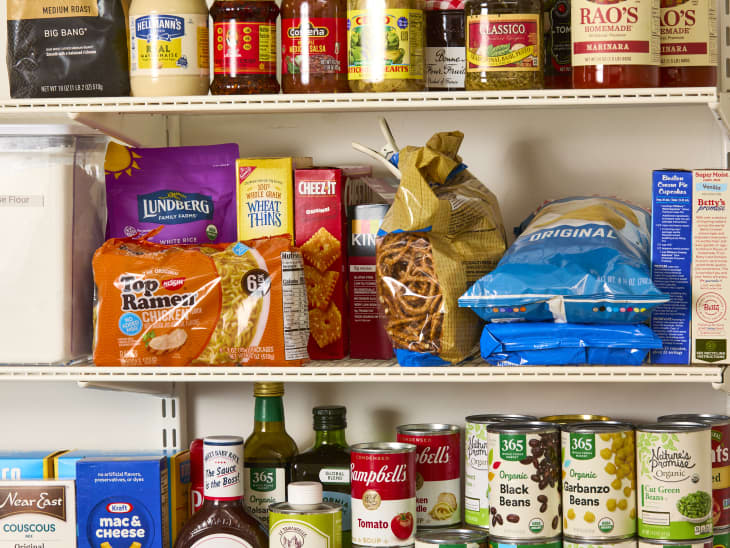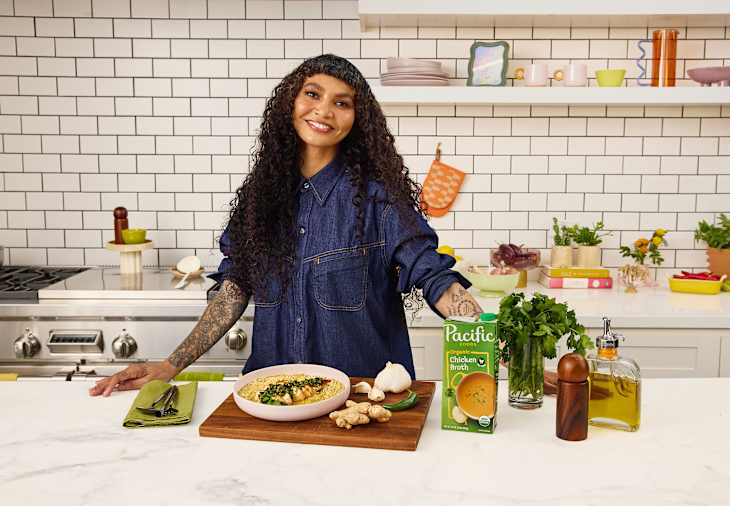

Sophia Roe is no stranger to the kitchen. The James Beard award-winning chef has catered everything from intimate dinners to the Met Gala, and hosted television shows for VICE, Tastemade, and Toast, among others. Recently she hosted a dinner alongside other food content creators with Pacific Foods in New York City that I got to attend. Prior to the dinner, I spoke with Sophia and got a sneak peak on what she planned to cook for the evening. Here’s what she had to say.
Sophia self-admittedly loves “fussy food,” and can often be found whipping up artfully crafted dishes (such as salt-baked pears) in her culinary studio in Brooklyn, New York. Her pantry is always stocked with miso (“every kind, any kind”) as well as a variety of soy sauces. “Tamari, soy sauce, coconut aminos, nama shoyu — I always have it,” Sophia says. She also always has “really good fats” on hand, like butter and olive oil, as well as mushroom powders. “They’re really good for umami. You can make your own or buy them,” she says.
Sophia welcomed a baby, Mizu, this past summer, and she’s had to switch up her cooking style since becoming a mother. “I never was a meal prep girly. I was that go-to-the-farmers-market, see-what-they-got, a lot more intuitive [kind of cook]. I can’t do that anymore,” Sophia says. Now, she gets a big grocery delivery every weekend, cleans and preps her proteins, and meal preps simple things like sweet potatoes, rice, and sauces to easily grab throughout the week.
“I’m doing a lot more passive cooking, like throwing it all in a pot, putting it in the oven for three hours, kind of food that’ll last me a day or two. Luckily, we’re in that soup [and] stew season.” Another go-to technique of hers is dry-brining. “It’s the least I could do,” she says “I dry brine everything. It’s just the way it tastes the best and because we’re doing everything kind of low and slow.”
Sophia’s work is multifaceted. She’s equally as passionate about advocating for food justice and building more sustainable and equitable spaces. “The biggest thing I think people need to do is get off their phones. Because the second you get off your phone, your world becomes real again. Come back to your community. I think people think in order to make a difference, they have to do it all. They have to figure out how to change the world. You can change the world by changing your block,” she says.

A sense of community was definitely felt at the Pacific Foods dinner that evening. The event was a part of the brand’s Kitchen Passport Series, which invited different cooks to utilize one of the broths as a jumping-off point to start their own global culinary adventure. “I’ve always got broth in the house,” Sophia says, so the partnership just seemed natural. She also loves that the broth comes salted and unsalted “because you never know who you’re making food for.”
But what she did with the broth really blew my mind and featured a technique I’ve never seen done before with a staple I always have in my pantry: steeping tea bags in it. “I always have a lot of tea because I think that tea can really enhance a lot of things that you’re making,” Sophia says. “I think people sleep on tea. People are like, Oh, I drink tea and it’s so delicious. And I’m thinking of all the ways that you can apply tea to a sauce or a liquid or a stock or a stew. I don’t remember the last time I made a low-and-slow something without a tea bag of some kind.”
To elevate the broth, Sophia steeped ginger tea bags directly in it for the base of her ginger tea chicken & rice with scallion sauce. “I made this ginger tea soup, essentially. I steep a bunch of ginger tea bags in the broth and add a bunch of aromatics, like clove and star anise, to just really punch up this already-flavorful broth in a way that feels very seasonally relevant.”
But you don’t have to just use it for soups and stews. Add tea into your oatmeal, or use it as the base for cooking grains like rice, farro, or quinoa. Sophia also suggests using it to cook beans. “We’re always hearing about cooking beans in water. Why would you cook them in water when you could cook them in tea? I just think broth is a more exciting base than water.”
Have you used tea in an unconventional way before? Let us know in the comments.